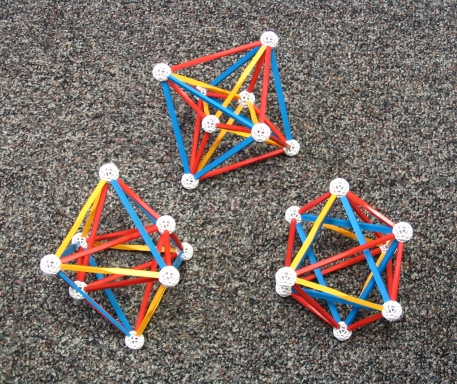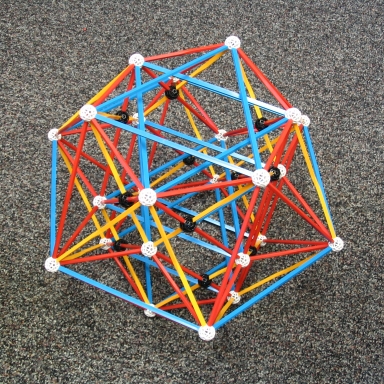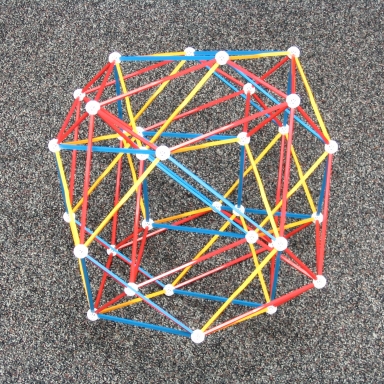Triality with Zometool
Introduction
This page is about
"triality"
in the Zome System.
Consider the followiong three Zometool models of the 16-cell:

Zome Projections of the 16-Cell
Notice that each of these models is uses 8 connectors, 6 R1 struts, 6 R2 struts, 6 Y2 struts, and 6 B2 struts. Each model has two B2 equilateral triangles, each of which uses three connectors. For each model, the two remaining connectors lie on an axis of trihedral symmetry. For each model, there is a unique strut type among {R1,R2,Y2} which does not emanate from this trihedral axis. We therefore have a sort of triality, provided we ignore the distinction between yellow and red struts.

Zome Projection of the 24-Cell
Truncating the regular 16-cell to its edge midpoints yields the regular 24-cell. As a matter of fact, truncating any one of these models in this manner yields the same Zome model of the 24-cell. Thus, we have more evidence of a triality underlying these models. We shall see that this triality is a manifestation of the triality in the D(4) root system.
Quaternions and the 600-Cell
The purpose here is to see a somewhat non-intuitive construction of the 24-cell using the Zome System model of the regular 600-cell. This construction reveals that the binary icosahedral group is intimately related to D(4) triality.
The vertex sets for the three models of the 16-cell pictured above are imbedded in a particular way in the vertex set for the 600-cell, and there is some convenient notation for this set if one is willing to work with quaternions. Let Q={±1,±i,±j,±k} be the usual 8-element group of quaternions, where the elements satisfy Hamilton's equation,
Let b=½(1+√5) denote the Golden Ratio and a=½(1-√5) be its field-theoretic conjugate, and define a quaternion by
Next, define the "binary icosahedral group" I to be the smallest group of quaternions containing i and ½(ai+j+bk), where b is the Golden Ratio and a is its field-theoretic conjugate. Then I contains T as a subgroup, and it also has the 96 quaternions which can be produced from
The elements of the groups Q, T, and I, as expressed here with quaternions, provide convenient notation for vertex sets of 4-dimensional regular polytopes. For example, the elements of Q coincide with the vertices of a regular 16-cell, the elements of T are the vertices of a regular 24-cell, and the elements of I are the vertices of a regular 600-cell. Moreover, since quaternion multiplication amounts to an orthogonal transformation, multiplying any of these sets by a fixed non-zero quaternion also yields vertex sets of the same polytopes.
If q is any non-zero quaternion, and G is any one of the groups {Q,T,I}, then let qG (respectively Gq) denote the set of all products of the form qx (respectively xq) where x is a quaternion in G.
The Zometool Models
In order to see the triality, consider the vertex set 2(1+i)I, obtained by multiplying each element of I by 2(1+i). This transformation is a composition with a "rotation" by π/4 with a dilation by √8. This set is invariant under the group generated by all permutations and all even numbers of sign changes in the four coordinates, but there are four orbits under this action. We may specify orbit representatives as
One can see the triality by examining the first three orbits described above. Denote
Next, one can check that the union of the three vertex sets of [a], [1], and [b] coincide with the vertices of a 24-cell. Indeed, one has
|
|
|
|
The Coxeter Graph D(4)


